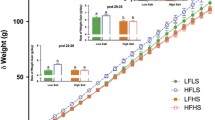Abstract
An increased salt appetite is usually considered to be present when animals, choosing between water and hypertonic NaCl solution (1.8%, 2.7 or 4.5%) drink more of the apparently aversive salt solution than normal animals (1, 5, 7). Overcoming the aversive taste of the concentrated NaCl solution is taken as an expression of motivation for salt intake. We investigated the validity of this assumption. If it is correct, animals with an increased salt appetite should also drink increased amounts of a 0.9% NaCl solution made aversive by adding bitter substances and given as a choice to water, provided that the taste of the NaCl is not masked by the bitter substance. If salt-appetite is regulatory, more bitter 0.9% NaCl than 1.8 or 2.7 NaCl should be chosen by salt-hungry rats.
(Supported by Swiss National Science Foundation, Grant Nr. 3.220-082)
Access this chapter
Tax calculation will be finalised at checkout
Purchases are for personal use only
Preview
Unable to display preview. Download preview PDF.
Similar content being viewed by others
References
J. K. Bare, The specific hunger for sodium chloride in normal and adenalectomized white rats. J. Comp.Physiol. Psychol., 42, 242–249 (1949).
W. G. Clark, D.F. Clausen, Dietary “self-selection” and appetites of untreated and treated adrenalectomized rats. Am.J. Physiol., 139, 70–79 (1943)
A. N. Epstein, E. Stellar, The control of self-preference in the adrenalectomized rat. J. Comp.Physiol.Psychol., 48, 167–181, (1955).
G. Peters, Aufnahme und renale Ausscheidung von Wasser und Salzen bei freiem Nahrungs-und Trinkflüssigkeitsangebot: ihre Beeinflussung durch Adrenalektomie und Behandlung mit Nebennierenrindenhormonen bei der Ratte.-Arch. exp. Path. u. Pharmakol., 235, 205–229, (1959).
G. Peters, Nebennierenrinden-Inkretion und Wasser-Elektrolythaushalt. Leipzig, VEB Georg Thieme-Verlag, (1960). Pg. 122–127 for references.
C. P. Richter, J.F. Eckert, Mineral metabolism of adrenalectomized rats studied by the appetite method. Endocrinology, 22, 214–225, (1938)
G. Wolf, J. F. McGovern, L.V. Di Cara, Sodium appetite: some conceptual and methodologic aspects of a model drive system. Behavioral Biol., 10, 27–35, (1974).
Author information
Authors and Affiliations
Editor information
Editors and Affiliations
Rights and permissions
Copyright information
© 1986 Springer Science+Business Media New York
About this chapter
Cite this chapter
Mueli, C., Peters, G. (1986). The Nature of the Salt Appetite of Adrenalectomized Rats. In: de Caro, G., Epstein, A.N., Massi, M. (eds) The Physiology of Thirst and Sodium Appetite. NATO ASI Series, vol 105. Springer, Boston, MA. https://doi.org/10.1007/978-1-4757-0366-5_61
Download citation
DOI: https://doi.org/10.1007/978-1-4757-0366-5_61
Publisher Name: Springer, Boston, MA
Print ISBN: 978-1-4757-0368-9
Online ISBN: 978-1-4757-0366-5
eBook Packages: Springer Book Archive




